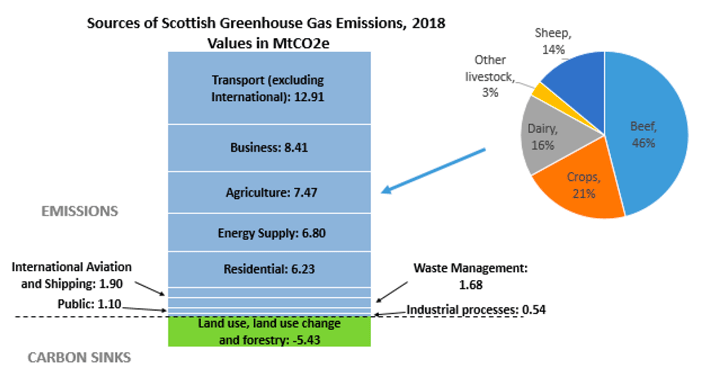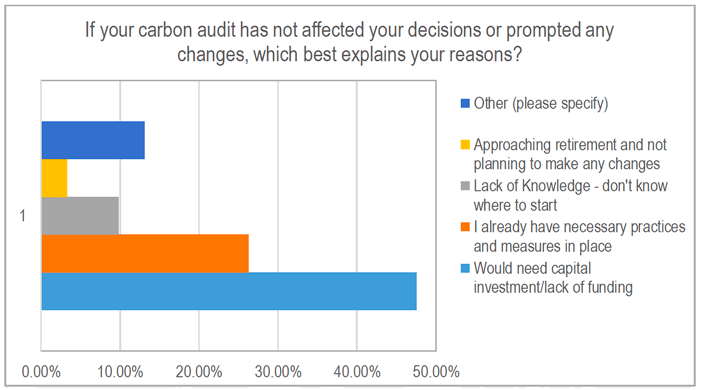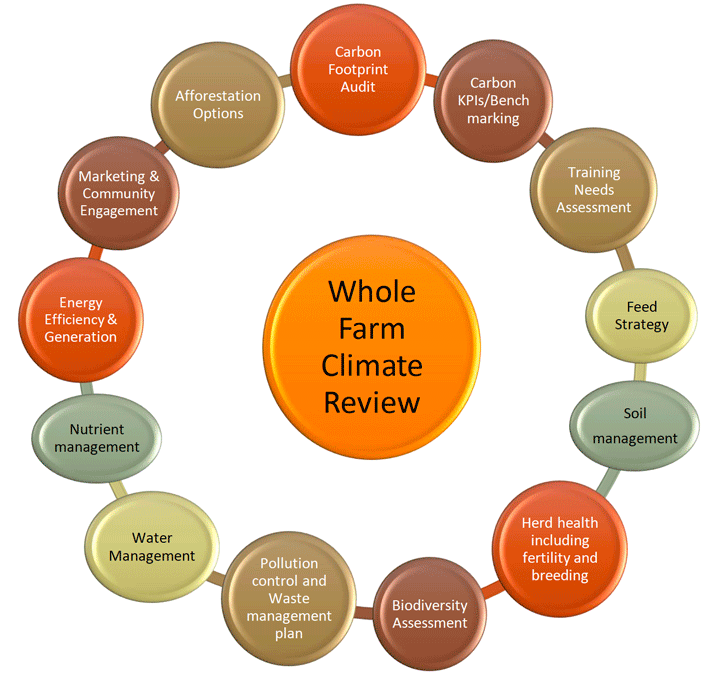Dairy Sector Climate Change Group: report
Report from the Dairy Sector Climate Change Group, one of the farmer-led groups established to develop advice and proposals for the Scottish Government. It focusses on how to cut emissions and tackle climate change, something that was re-emphasised in the updated Climate Change Plan.
5. Establishing the Baseline
5.1 The Inventory and Targets
Accurate assessment of GHG emissions from agriculture is more challenging than for other sectors because of the need to quantify multiple inter-related biological production processes. The data on agricultural GHG emissions are compiled for all parts of the UK by a consortium of independent contractors and recorded in a national inventory which measures progress towards reduction targets. While there are three major GHGs (Carbon Dioxide, Methane and Nitrous Oxide) for ease of comparison, all GHGs are converted into Carbon Dioxide equivalents and split by sector of the economy. In 2018, the estimated emissions from agriculture made it the third largest emitter in the UK, behind transport and business.
As shown in Figure 3, in 2018, total Scottish emissions were estimated to be 41.6 million tonnes of carbon dioxide equivalent (MtCO2e) and agriculture accounted for 7.5 MtCO2e so an 18% share of total emissions. Only very approximate figures can be provided within the inventory for the dairy sector, which crudely estimate dairy cattle contributed 1.17 MtCO2e or 16% of agricultural emissions.

The approach by Scottish Government is to disaggregate the total emissions and create industry specific targets accordingly. The sectoral envelope for Scottish agriculture set out in the CCPu requires it to reduce its emissions to 5.3 MtCO2e by 2032, a 31% reduction from 2018 levels (which would require reduction at four times the pace of historic reductions). Whilst such stark targets may increase the urgency of action, we suggest it is too blunt a tool which does not adequately reflect the multiple priorities delivered by agriculture nor the negative outcomes of the alternatives for feeding the population. For example, it may appear in theory a simple solution to drastically reduce cattle numbers to meet an otherwise seemingly impossible target reduction in emissions, but this takes no account of the economic and social significance of livestock farming to Scotland plc, its infrastructure, the health and welfare of its people and landscapes.
In our view, it is only when the industry baseline has been established that sectoral targets could be considered, but not if the complexity incorporates greater uncertainty and undermines confidence in the process. Benchmarking will play an important role in delivering change and target achievement, and as the information will be specific to each farm it will be of the greatest relevance.
Whatever the arguments regarding targets, the inventory is an important tool because it guides us in terms of which emission reduction activities (mitigation measures) will make a difference in terms of reducing the total emissions contributed by agriculture and the UK inventory results are the ones reported to the IPCC, by which compliance with international agreements are evaluated. There is no doubt there is room for improvement. As emissions by other sectors reduce, the spotlight may increasingly shine on agriculture, however, a tendency for reductive bias may increase pressure on dietary change away from meat and dairy consumption as a means of tackling the problem.
Some activities farmers may undertake which improve their carbon footprint, such as renewable energy generation, may not be reflected in the agriculture section of the inventory and therefore those activities are not credited in agriculture target. Equally, the carbon stored in soil contributes towards the positive side of the inventory but this is not offset against the agricultural emissions section.
While the Scottish Government cannot unilaterally amend the inventory, it should influence how it develops to properly reflect Scottish agriculture. The inventory is not a static document and it must evolve with technology and research. For example, the methodology for agriculture has recently changed to reflect management practices and is called the "smart inventory". However, the smart inventory still only reflects mitigation activity for which there is robust data and analysis so further work must be done in this area to properly reflect Scottish agriculture and ensure adequate Scottish data is included. The data collected during the baselining exercise should be made available and feed into inventory reviews.
Recommendations:
- Prioritisation of the continuous improvement of the 'smart inventory' to increase accuracy for emissions and sequestration within Scottish agriculture.
Refer to Annex 4 – Recommendations and Support Required
5.2 Carbon Footprint Audits - Standardising the Data Collection
Understanding the contribution to emissions is a first step towards defining low-carbon pathways.[14] Farm level carbon auditing is recognised as one method to achieve this[15]. Within the dairy sector, a significant proportion of dairy farms have carbon audited, some annually for a number of years. However, to date these audits have been carried out using different models (of which over 64 have been identified[16]), with differing comprehensiveness and practicality. Whilst all the models are required to operate to the same international standard (IPPC, PAC2050), there is no standardised collation of this data and going forward this should be a priority.
For the dairy sector, and agriculture as a whole, to measure its improvement there needs to be a standard baseline established. Given the complex interactions between sectors, this cannot be sector specific. For the data to be meaningful and robust, it would need to be a single auditing tool used, in a defined timescale and independently inputted. In addition, further baseline inputs should be considered, such as soil carbon, biodiversity, water quality and ammonia emissions.
Work must be prioritised to increase the level of transparency, accuracy and sophistication of the auditing tools, particularly with regard to mitigation and off-setting. A modular tool which can differentiate between mitigation measures already captured in the smart inventory, (see Figure 9), as well as those for this more robust data or analysis is needed is required in terms of achieving multiple benefits from the audits including ongoing improvements to the smart inventory for agriculture.
Carbon footprinting is, like all modelling, based upon assumptions and some will be more accurate than others. We must also acknowledge the limitations within the auditing tools and the confidence intervals of the assumptions. Similarly, there will also be interactions between measures, and the ability of the tools to correctly reflect these interactions needs to be explored.
While acknowledging there is ongoing work to be done in terms of the auditing tools, the process of setting the baseline should be commenced as soon as possible. A pilot scheme should be initiated selecting one of the currently available tools, informed by an updated review of the main carbon footprinting tools[17]. For many farmers already participating in carbon auditing, for example in conjunction with their milk buyer, this would result in duplication of effort. However, with action to standardise the data and assumptions of available tools, this duplication could be minimised thereafter. An analogy could be the health care system where the freely available national system is open to all but others may choose to bolt on or adapt an enhanced tool if they wish, although all should meet a standard.
Experience from other parts of the world should be drawn upon – for example New Zealand has developed the Overseer tool which feeds into a database the government can access[18] as well as a user-friendly suite of documents and standardised carbon calculator tool for use by farmers[19]. However, to ensure the robustness of the data and credibility of the baseline, a suitably trained third party should be used to collect and input the data on farm, at least initially. As knowledge transfer and training programmes progress, then a system could be considered where data is primarily collected by the farmer but with spot checks and inspections for a random sample to ensure accountability and credibility is preserved.
The baseline data for each farm should also be presented in an adaptive way to allow farmers to carry out scenario analysis, so they can measure the impact implementation of possible measures would make. Thereby focussing efforts on the measures that would have most impact for their system.
Our farmer survey revealed that around two thirds of dairy farmers had already carried out a carbon audit (although for nearly 20% more than a year ago) or were planning to do so. Most had done so as a requirement of their milk buyer's contract but worryingly, half of those who had carried out an audit had not made any changes as a result. Of those, the main reason for lack of action was the need for capital investment/ lack of funding but lack of knowledge was also a factor, (Figure 4).

| Answer Choices | Responses |
|---|---|
| Other (please specify) | 13.11% |
| Approaching retirement and not planning to make any changes | 3.28% |
| Lack of knowledge - don't know where to start | 9.84% |
| I already have necessary practices and measures in place | 26.23% |
| Would need capital investment - lack of funding | 47.54% |
The results of our survey confirm that setting the baseline should be accompanied by the appropriate support, training, planning tools and funding to ensure targeted action is taken at farm level and that the carbon audit does not simply become a tick box exercise.
Recommendations:
- Standardisation and transparency of existing carbon footprinting tools.
- Consistent and widespread whole industry carbon auditing, to provide a baseline from which to measure improvement and help improve the inventory.
- Development of scenario planning within the auditing tool to enable farmers and advisers to measure impact of measures on their footprint before implementation, and benchmarking of results.
Refer to Annex 4 – Recommendations and Support Required
5.3 Whole Farm Climate Reviews
A carbon audit is a good start to assessing the baseline carbon footprint for Scottish agriculture but if the exercise is to result in real change at farm level then we believe the carbon audit should be one part of a wider suite of training, planning and measures that every farm should undertake as a gateway to further funding. We have called this a "Whole Farm Climate Review". Adopting a strategy that considers the entire production system leads to cumulative gains across multiple areas and results in a more significant reduction in carbon footprint[20].
A whole farm approach also considers interaction between measures, some providing enhanced benefits when implemented jointly (e.g., genomics and breeding), others mutually dependent to deliver mitigation (e.g., covering slurry stores must be accompanied by low emission spreading techniques) and some non-additive in their mitigation potential (e.g., 3NOP feed additive and breeding for low methane emissions). There is a lack of quantitative evidence of the cumulative and interactive effects of implementing multiple mitigation strategies on GHG emissions[21], but this can be informed by life cycle analysis[22] to provide a holistic framework and consider the wider supply chain implications, e.g., sustainable purchased feed sources, efficiency of purchased replacements
Significant reductions in emissions and improvements in emissions intensity can be achieved through best practice and increasing efficiencies across a farm business no matter what the system. The cumulative effect of a particular combination of mitigation and efficiency measures needs to be understood at individual farm level. The optimum position will be different for each farm.
There are integrated farm management tools already available so many farmers are familiar with the concept, but we believe that a Whole Farm Climate Review tool should be developed in a modular way so that each farm can adapt the review to its own circumstances and produce the optimum plan for the business to achieve its best outcome in terms of emission reductions and emission intensity and help identify business and funding opportunities.
Once the farm level situation is understood and measured, farmers must be able to benchmark their emissions with others and forecast the effect of possible interventions both for emission reductions and offsetting. With farm assurance and cross compliance requirements focussing on the delivery of soil/silage/slurry analysis, animal health plans and nutrient budget, consideration needs to be given as to the collation and benchmarking of this data. The benefit to the farmer needs to be at the heart of the objective, by avoiding a tick box list of reports and focussing on delivering meaningful information to enable change.

The Whole Farm Climate Review would also provide the gateway to future capital funding with mitigation priorities identified as part of the strategic review. It would be a living document with periodic reviews and updating, with continued funding to support the process.
A full life cycle analysis of a selection of dairy farms would consider the wider interactions between sectors and supply chains.
Recommendations:
- Whole Farm Climate Review available to all farms to analyse the baseline data, provide benchmarking, and identify areas for action. This would be the gateway to future capital funding.
- Full life cycle analysis of a selection of dairy farms to consider the wider interactions between sectors and supply chains, and international comparisons.
Refer to Annex 4 – Recommendations and Support Required
Contact
There is a problem
Thanks for your feedback